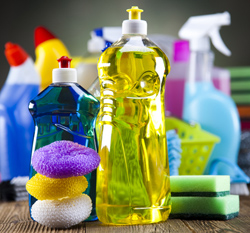5 Potentially Harmful Chemicals in Your Cleaning Products and Their Alternatives

Homeowners have become more conscientious with the chemical products they use around the house, but some of the most common cleaning agents contain potentially harmful chemicals we might not expect to find. Luckily, most of these things can be replaced by safer alternatives that are better for your family and the environment. Read the labels of your household cleaners and look for these possibly harmful chemicals:
Ammonia
Ammonia is a common chemical found in all-purpose cleaners, kitchen and bathroom cleaners, any kind of antibacterial solution, furniture polish and window and glass cleaners. Ammonia fumes can irritate your lungs and eyes and, if you come into physical contact with it, burn your skin or cause a rash. Never mix ammonia with bleach, as it produces a gas that can cause serious respiratory problems or even death. Instead of using an ammonia-based cleaning solution in your home, try mixing white vinegar with lemon juice or using pure castile soap.
Triclosan
Triclosan is most often found in dishwasher detergents, hand soaps, hand sanitizers and anything labeled as antimicrobial. The chemical can also be found in others things with antimicrobial properties such as hoses, toys or even socks. Tests are still being done on triclosan to determine just how harmful it may be, but according to The Breast Cancer Fund, the chemical can affect the hormonal balance (especially the thyroid and metabolic system) and affect breast development. To avoid this chemical, stick to simple and natural soaps and detergents that are not antimicrobial. If you use hand sanitizer, stick to an alcohol-based brand.
Chlorine
Chlorine is found in many household products such as toilet bowl cleaners, scrubbing powders, laundry whitening agents, mold removers and pool cleaners. Chlorine can cause eye, throat and lung irritation and burning and, more seriously, chronic respiratory problems. For cleaning supplies, substitute baking soda for scouring, vinegar for cleaning and borax for laundry whitening. For your swimming pool, consider using the chlorine alternative bromine, an active sanitizer that has few to no irritating effects.
Phthalates
Phthalates is known to disrupt the endocrine system, and a 2003 study conducted by the Centers for Disease Control and Prevention and the Harvard School of Public Health found that men exposed to phthalates had a reduced sperm count. Unfortunately, companies do not have to disclose having phthalates in their products, but they are found in almost anything that lists “fragrance” as an ingredient and can be absorbed through inhalation or skin contact. As an alternative, use soaps and other products that are listed as “fragrance free.” Instead of using plug-in or aerosol air fresheners, use essential oils and soy or beeswax candles.
Sodium Hydroxide
More commonly known as lye, sodium hydroxide is found in heavy-duty cleaning products such as drain unclogging solutions and oven cleaners. Lye is extremely dangerous if it comes into contact with skin. It is a highly corrosive element that can cause severe burns on the skin or damage the throat and windpipe if inhaled. Clean your oven with a baking soda and vinegar mixture—it may take a little more hard work, but you’ll be happy you did.




